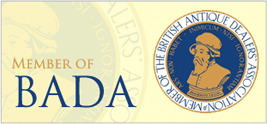| Steppes Hill Farm Antiques Newsletter #12 - June 2012 |
 |

A tricky problem most of us do not face today is how to extract the scrumptious contents from the constricted interiors of roasted Marrow Bones. A silver Marrow Scoop is an elegant solution to the problem and prevents the diner having to completely abandon his table manners!

New rules of etiquette for dining appeared during the 17th century and the introduction of Forks helped people to eat with a less hands-on approach to cooked food, but forks didn't help take the savoury jelly out of marrowbones. You can get an idea of how this was done once upon a time by reading a mid-17th century etiquette book. The author thought it best for people to stop handling and "mouthing" bones altogether, but he would allow you to use one hand for meat bones as long as there was no gnawing, sucking, slurping etc. And definitely no banging, cracking, or biting. Get the marrow out neatly and decently – with a knife:-
"Suck no bones...Take them not with two hands...Gnaw them not...Knock no bones upon thy bread, or trencher, to get out the marrow of them, but get out the marrow with a knife...To speake better...it is not fit to handle bones, and much lesse to mouth them. Make not use of a knife to breake bones...also breake them not with thy teeth, or other thing, but let them alone".
(Youths [sic] behaviour, trans. from French by Francis Hawkins, 1646)
Before the end of the century Marrow Spoons had arrived, starting in the 1690s. These new implements for eating marrow had a rounded spoon at one end with a narrow scoop at the other. Most 17th century examples are gilded and engraved with stylised leaf work and their stems are distinctively short. They soon evolved into the more practical Marrow Scoop with two different sized scoops, one at either end, joined in the centre by a short stem. Many were made during the 18th and 19th centuries in a great variety of styles and patterns and they can be found from all the English, Scottish and Irish assay offices.
Marrow bones were obviously still a prized commodity in the late 19th century as this recipe from Mrs Beeton's Book of Household Management proves:-
 Ingredients.–Bones, a small piece of common paste [pastry], a floured cloth. Ingredients.–Bones, a small piece of common paste [pastry], a floured cloth.
Mode.– Have the bones neatly sawed into convenient sizes, and cover the ends with a small piece of common crust, made with flour and water. Over this tie a floured cloth, and place them upright in a saucepan of boiling water, taking care there is sufficient to cover the bones. Boil the bones for 2 hours, remove the cloth and paste, and serve them upright on a napkin with dry toast. Many persons clear the marrow from the bones after they are cooked, spread it over a slice of toast, and add a seasoning of pepper; when served in this manner, it must be very expeditiously sent to table, as it so soon gets cold... Marrow-bones may be baked after preparing them as in the preceding recipe; they should be laid in a deep dish, and baked for 2 hours.
(Isabella Beeton's recipe from 1861)
The end of the Marrow Scoop came with meat rationing in the Second World War when it was not possible to buy joints of the size which would contain a bone from which marrow could be scooped.
You might (or might not) be tempted to try some (see video clip for recipe):-
http://www.5min.com/Video/How-to-Roast-Marrow-Bones-215137995


I am pleased to be able to offer some interesting new items of stock this month and recent finds include; a rare Dr Wall Worcester Slop Bowl of small size, a George V Silver Butt Marker with 12 pegs, an Early Worcester "Fringed Tree" Sauce Boat, a rare Victorian Novelty Silver Railway Lamp Telescopic Propelling Pencil, a Worcester Yellow Ground Pierced Basket, a large Edwardian Silver Cow Pin Cushion, a rare Early Derby Cruciform Cream Boat and an unusual Scottish Silver Pipe Case & Pipe.

I do hope that you will find this Newsletter informative and helpful and will allow us send it to you on a regular basis. I would welcome any feedback you may have, both positive and negative.
David W.A. Buck.
Steppes Hill Farm Antiques |
|

 |
 |
|

